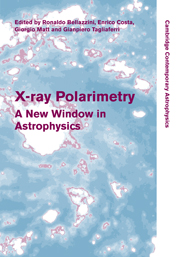Book contents
- Frontmatter
- Contents
- List of contributors
- Preface
- 1 X-ray polarimetry: historical remarks and other considerations
- Part I Polarimetry techniques
- 2 Scattering polarimetry in high-energy astronomy
- 3 Photoelectric polarimeters
- 4 Bragg crystal polarimeters
- 5 X-ray polarimetry with the photon-counting pixel detector Timepix
- 6 High-energy polarized photon interactions with matter: simulations with Geant4
- 7 The GPD as a polarimeter: theory and facts
- 8 Ideal gas electron multipliers (GEMs) for X-ray polarimeters
- 9 Broad-band soft X-ray polarimetry
- 10 Feasibility of X-ray photoelectric polarimeters with large field of view
- 11 Angular resolution of a photoelectric polarimeter
- 12 Development of a Thomson X-ray polarimeter
- 13 Hard X-ray / soft gamma-ray polarimetry using a Laue lens
- Part II Polarized emission in X-ray sources
- Part III Future missions
- Author index
- Subject index
13 - Hard X-ray / soft gamma-ray polarimetry using a Laue lens
from Part I - Polarimetry techniques
Published online by Cambridge University Press: 06 July 2010
- Frontmatter
- Contents
- List of contributors
- Preface
- 1 X-ray polarimetry: historical remarks and other considerations
- Part I Polarimetry techniques
- 2 Scattering polarimetry in high-energy astronomy
- 3 Photoelectric polarimeters
- 4 Bragg crystal polarimeters
- 5 X-ray polarimetry with the photon-counting pixel detector Timepix
- 6 High-energy polarized photon interactions with matter: simulations with Geant4
- 7 The GPD as a polarimeter: theory and facts
- 8 Ideal gas electron multipliers (GEMs) for X-ray polarimeters
- 9 Broad-band soft X-ray polarimetry
- 10 Feasibility of X-ray photoelectric polarimeters with large field of view
- 11 Angular resolution of a photoelectric polarimeter
- 12 Development of a Thomson X-ray polarimeter
- 13 Hard X-ray / soft gamma-ray polarimetry using a Laue lens
- Part II Polarized emission in X-ray sources
- Part III Future missions
- Author index
- Subject index
Summary
Hard X-ray / soft gamma-ray polarimetric analysis can be performed efficiently by the study of Compton scattering anisotropy in a detector composed of fine pixels. But in the energy range above 100 keV where source fluxes are extremely weak and instrumental background very strong, such delicate measurement is actually very difficult to perform. The Laue lens is an emerging technology based on diffraction in crystals allowing the concentration of soft gamma-rays. This kind of optics can be applied to realize an efficient high-sensitivity and highangular-resolution telescope, though at the cost of a field of view reduced to a few arcmin. A 20-m focal-length telescope concept focusing in the 100–600 keV energy range is taken as example here to show that recent progresses in the domain of high-reflectivity crystals can lead to very appealing performance. The Laue lens being fully transparent to polarization, this kind of telescope would be well suited to perform polarimetric studies since the ideal focal plane is a stack of finely pixelated planar detectors – in order to reconstruct the point spread function – which is also ideal to perform Compton tracking of events.
Introduction
A Laue lens concentrates gamma-rays using Bragg diffraction in the volume of a large number of crystals arranged in concentric rings and accurately orientated in order to diffract radiation coming from infinity towards a common focal point (e.g.).
- Type
- Chapter
- Information
- X-ray PolarimetryA New Window in Astrophysics, pp. 88 - 92Publisher: Cambridge University PressPrint publication year: 2010
- 3
- Cited by

